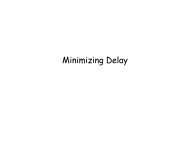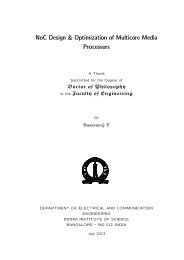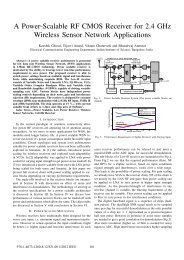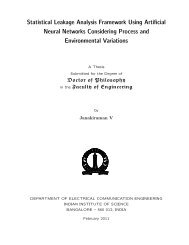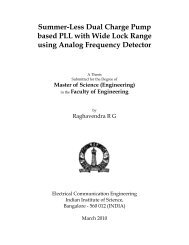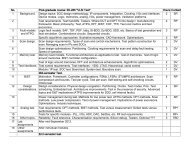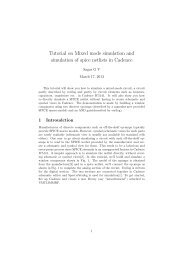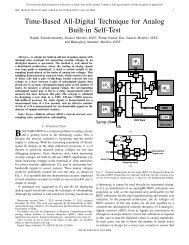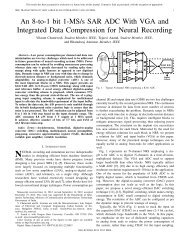An 8-to-1 bit 1-MS/s SAR ADC With VGA and Integrated Data ...
An 8-to-1 bit 1-MS/s SAR ADC With VGA and Integrated Data ...
An 8-to-1 bit 1-MS/s SAR ADC With VGA and Integrated Data ...
- No tags were found...
You also want an ePaper? Increase the reach of your titles
YUMPU automatically turns print PDFs into web optimized ePapers that Google loves.
This article has been accepted for inclusion in a future issue of this journal. Content is final as presented, with the exception of pagination.CHATURVEDI et al.: 8-TO-1 BIT 1-<strong>MS</strong>/s <strong>SAR</strong> <strong>ADC</strong> WITH <strong>VGA</strong> AND INTEGRATED DATA COMPRESSION 51) Power Saving in <strong>VGA</strong>: If T vga = α vga · T S , N-<strong>bit</strong> settlingerror is given byV err1 = V ( )ref2 N = V −Tvgaref · exp. (1)R eq · C DACAssuming output resistance R eq = β/I D where β is aconstant dependent on the architecture of the driver <strong>and</strong> I Dis the current consumed in the driverI D,vga,1 = N · ln(2) · β vga · C DAC. (2)α vga · T SNow for ping-pong input sampling α vga = 1InputCDAC−+<strong>SAR</strong><strong>ADC</strong>SpikeSortingDSPFig. 9. <strong>Data</strong>-rate reduction in NRS through the proposed activity-dependentA/D scheme.SthTxI D,vga,2 = N · ln(2) · β vga · C DACT S. (3)The percentage power saving can be calculated asI D,vga,1 − I D,vga,2= (1 − α vga ) · 100%. (4)I D,vga,12) Power Saving in Reference Buffer: If T ref = α ref · T S ,N-<strong>bit</strong> settling error due <strong>to</strong> the reference buffer is given byV err2 = V ( )ref2 N = V −(Tref )/2Nref · exp(5)R eq · C eqwhere C eq is the equivalent capacitance seen by the referencebuffer <strong>and</strong> 50 % of each <strong>bit</strong> cycle (T ref /N) is given for CDACsettlingI D,ref,1 = N · ln(2) · β ref · C eq· 2N. (6)α ref .T SFor ping-pong input sampling α ref = 1I D,ref,2 = N · ln(2) · β ref · C eq· 2N. (7)T SThe percentage power saving can be calculated asI D,ref,1 − I D,ref,2= (1 − α ref ) · 100%. (8)I D,ref,1Hence, for an 8-<strong>bit</strong> <strong>ADC</strong>, with 2 cycles given for samplingin the conventional approach, α vga = 0.2 <strong>and</strong>α ref = 0.8.Hence, 80% power can be saved in the <strong>VGA</strong> <strong>and</strong> 20% powercan be saved in the reference buffer by using ping-pongsampling scheme. Actually the power saving in the <strong>VGA</strong> islarger as the sampling capaci<strong>to</strong>rs (C in0 <strong>and</strong> C in1 in Fig. 8)are much smaller than C DAC (which is used as the samplingcapaci<strong>to</strong>r in the conventional sampling approach).The drawback of this architecture is the need for extrasampling capaci<strong>to</strong>rs. But as their sizes are determined bythermal noise <strong>and</strong> leakage at the <strong>to</strong>p plate switch but notmatching, the area penalty is not significant for moderate resolution(8–10 b) <strong>ADC</strong>s. The leakage from sampling capaci<strong>to</strong>rsbecomes more important consideration for higher resolution<strong>ADC</strong>s in technologies with larger leakage. This architecturealso requires good matching between two sampling paths fora single channel application <strong>and</strong> may need calibration [19].But no such requirement is imposed for multichannel input,as in NRS, where each channel (even or odd) traverses afixed path every time. It also alleviates the concern of dutycycle dis<strong>to</strong>rtion due <strong>to</strong> the half-rate clocking as even- <strong>and</strong>odd-numbered channels are sampled by two different nonoverlappingclocks.(a)Fig. 10. Effective activity fac<strong>to</strong>r. (a) Spike approximated as a triangularwaveform. (b) Important spike features for spike-sorting [15], [21].C. Activity-Dependent A/DThere is a great need <strong>to</strong> reduce the amount of data <strong>to</strong> betransmitted <strong>to</strong> enable chronic recording from more numberof channels. The information in extracellular action potential(EAP) is essentially encoded in spike time-stamps but theamplitude information in EAPs is also important for spikesorting [3]. Simple thresholding is found <strong>to</strong> be equally effectiveas other complex spike detection algorithms [20]. However,representing a spike as a point event causes loss of informationrequired for spike sorting. <strong>An</strong>other way <strong>to</strong> reduce the ODR isthe transmission of important spike features [1], [3]. Fig. 10(b)shows important spike features, A max (the maximum positivespike amplitude), A min (the minimum negative spike amplitude)<strong>and</strong> T pp (the time between A max <strong>and</strong> A min ), that shouldbe kept intact in the output of the <strong>ADC</strong> in a low ODR NRS[15], [21].In this paper, we propose an activity-dependent A/D conversionscheme <strong>to</strong> obviate the processing of background noisebut preserve important spike features. Figs. 9 <strong>and</strong> 10(a) illustratethe proposed scheme. In this, the digitization processis enabled only when the input is larger than the spikedetection threshold S TH . The spike detection threshold S TH isdecided based on the magnitude of the background noise (σ n ),S TH = μ sig + k.σ n where μ sig is the mean of the input <strong>and</strong>k = 3 − 4 so that the probability of the false detection ofthe noise as a spike is small [22]. Note that this schemeis exclusively for the neural recording application where theinformation is in spike time-stamps.Fig. 10(a) depicts the concept of the activity-dependentA/D. The spike is approximated as a triangular waveform withmaximum amplitude A max <strong>and</strong> spike duration T spike . Referring(b)



